So, you want to know how long your golf cart batteries will last. Let's get right to it: with proper care, you can generally expect a set of golf cart batteries to last somewhere between four and six years.
That lifespan can translate to hundreds of hours out on the course and thousands of miles exploring your community. But the real answer to "how long do golf cart batteries last?" isn't just a number—it depends heavily on the type of battery you have and how well you treat it.
The Real Lifespan of Golf Cart Batteries
It helps to think about your battery's lifespan less in terms of years and more in terms of the total energy it can deliver. It’s an investment, and understanding what affects its longevity is the first step to getting the best return on that investment—which means more rounds of golf, more neighborhood trips, and more work done around the property.
On average, a good golf cart battery will give you between 500 to 1,500 hours of run time. With every full charge, you’re looking at a range of about 25 to 40 miles, making your battery's health a huge factor in your cart's daily usefulness.
This image really drives home the difference between the two main battery types you'll find today.

As you can see, modern lithium batteries can easily double the lifespan of traditional lead-acid batteries, even when used under the same conditions.
A Quick Comparison of Battery Types
In the world of golf carts, the two main players are old-school lead-acid batteries and their modern lithium-ion cousins. They're built differently, require different levels of care, and come at different price points, all of which directly impact how long they’ll last.
A battery's true value isn't just its upfront price, but its cost per year of reliable service. A longer-lasting battery often provides a better return on investment, even with a higher initial cost.
To help you see the differences clearly, we've put together a quick comparison. If you want to go even deeper, check out our complete guide to golf cart battery lifespan to make sure you're making the best choice when it's time to buy or replace.
Golf Cart Battery Lifespan at a Glance
This table breaks down the core trade-offs between the two most common battery technologies.
| Battery Type | Average Lifespan (Years) | Maintenance Needs | Upfront Cost |
|---|---|---|---|
| Lead-Acid | 4 - 6 | High (Requires watering & cleaning) | Lower |
| Lithium-Ion | 8 - 10 | Very Low (Essentially maintenance-free) | Higher |
The choice really comes down to this: lead-acid batteries are cheaper to buy but demand more of your time and have a shorter life. Lithium, on the other hand, offers a longer-lasting, hassle-free experience for a higher initial price.
Why Your Golf Cart Battery Is a Marathon Runner

Ever wondered why a golf cart battery can cruise through 18 holes without breaking a sweat, but a car battery gives up the ghost if you just leave the radio on? It all comes down to what they were built to do. A car battery is a sprinter. Its one big job is to deliver a massive jolt of power to crank the engine, and then it gets to kick back and recharge.
Your golf cart battery, on the other hand, is a true marathon runner. It wasn't designed for a quick burst of speed but for pure, sustained endurance. Its entire mission is to provide a steady, reliable stream of power for hours on end, getting you from the first tee to the 18th green and back to the clubhouse.
This incredible stamina is all thanks to its deep-cycle design, a technology that makes it fundamentally different from a standard car battery. Getting a handle on this one concept is the key to understanding how long your batteries will last and how to get the most out of them.
Built for the Long Haul
So, what exactly makes a deep-cycle battery a marathoner? The secret is in its internal construction. While a car battery uses thin plates to release a ton of power all at once, deep-cycle batteries are made with much thicker, more robust lead plates.
These heavy-duty plates are engineered to be drained down and charged back up, over and over again. This process is called a "cycle." Draining a car battery this way would destroy it in no time, but a golf cart battery is built to handle hundreds—or even thousands—of these cycles throughout its life.
The core difference is resilience. A deep-cycle battery is engineered to be deeply drained and fully recharged repeatedly, which would permanently damage a standard car battery after only a few instances.
This unique build is precisely why a well-maintained set of golf cart batteries can serve you for years. The average lifespan is typically between four to six years, which is quite a bit longer than most car batteries. This longevity is possible because their deep-cycle engineering can handle being discharged down to as low as 20% capacity without suffering permanent damage. For comparison, a car battery can be seriously harmed if it drops below 75% capacity. You can find more great info on this in the latest battery technology reports.
Understanding the Discharge and Recharge Cycle
Every time you take your cart for a spin and then plug it in to recharge, you're completing one full charge cycle. The total number of cycles a battery can withstand before it starts losing its ability to hold a charge is a huge factor in its overall lifespan.
Here’s how this marathon-like ability benefits you directly on the course:
- Consistent Power: It provides a steady voltage, so your cart maintains its speed and doesn't feel sluggish as the battery drains.
- Deep Draining: You can use most of the battery’s stored power without worrying about causing immediate, catastrophic damage.
- Long-Term Durability: It's built from the ground up to survive the constant demands of regular use.
Grasping this "marathon runner vs. sprinter" distinction is critical. It’s the reason why specific maintenance, like proper watering for lead-acid types and following the right charging procedures for all batteries, is so vital for preserving the health and longevity of your cart’s power source.
Lead-Acid vs. Lithium: The Ultimate Battery Showdown

When it's time to power your golf cart, you’re essentially choosing between two totally different philosophies: the old-school, dependable lead-acid battery and its modern, high-octane cousin, the lithium-ion battery. They both get the job done, sure, but their differences run deep, affecting everything from your daily routine to your wallet in the long run.
Think of it like choosing between a classic pickup truck and a new electric sedan. The old truck is cheaper to buy, but it needs constant oil changes, tune-ups, and guzzles more gas. The electric car has a higher sticker price, but you'll save a ton of time and money on maintenance and fuel down the road. That’s the lead-acid versus lithium debate in a nutshell.
The Real-World Performance Gap
The biggest differences between these two batteries really show up in their day-to-day performance and the upkeep they demand. For anyone who uses their cart regularly—whether it’s for a round of golf or cruising around the community—these factors are just as critical as the battery's overall lifespan.
Recent breakthroughs have only made the performance gap wider. While a traditional lead-acid battery will typically give you 3 to 5 years of service, it comes with the chore of regular watering and terminal cleaning. On the other hand, the latest lithium-ion batteries can easily last 8 to 10 years or more with virtually zero maintenance. If you want to dive deeper, you can learn more about what impacts golf cart battery life and how to get the most out of it.
This divide in longevity and maintenance creates two completely different ownership experiences.
For fleet managers and busy cart owners, the "set it and forget it" nature of lithium is a game-changer. The time saved on maintenance alone translates into major operational savings and more time on the path for every cart.
Key Differences in Daily Use
So, what does this showdown mean for how you actually use your golf cart every day? The perks of lithium become obvious the moment you look at charging speed, weight, and how the power feels under your foot.
Here’s a practical look at what to expect:
- Charging Time: A lead-acid battery pack needs a full 8-10 hours to get back to 100%. In stark contrast, a lithium battery is ready to go after just 2-4 hours of charging, getting you back out there significantly faster.
- Weight: This is a big one. Lithium batteries are up to 70% lighter than lead-acid batteries. That diet makes your cart feel nimbler, improves acceleration, and reduces wear and tear on your tires and suspension over time.
- Power Consistency: Ever notice your cart getting sluggish as the battery drains, especially on hills? That’s "voltage sag," a classic lead-acid problem. Lithium batteries deliver consistent, full power right until they're nearly empty, so your cart performs at its peak for almost the entire charge.
This table really spells out the trade-offs that determine not only how long your batteries will last but also how they’ll perform.
| Feature | Lead-Acid Battery | Lithium-Ion Battery |
|---|---|---|
| Charge Time | 8-10 hours | 2-4 hours |
| Weight | Heavy | Lightweight |
| Maintenance | Regular (watering, cleaning) | Virtually None |
| Lifespan | 3-5 Years | 8-10+ Years |
Ultimately, while lead-acid batteries might save you some money upfront, lithium batteries almost always deliver better long-term value. Their extended lifespan, maintenance-free design, and superior performance make them a smart investment for any serious golf cart owner.
The Hidden Killers of Battery Health
Knowing how long your golf cart batteries should last is one thing. Actually getting them to that finish line is another battle entirely. To hit that ideal lifespan, you first have to recognize the common habits and conditions that secretly chip away at their health. These "hidden killers" can age your batteries prematurely, forcing you into an expensive replacement years before you should have to.
Think of your battery pack like a high-performance engine. If you skip oil changes, use the wrong fuel, and constantly redline it, you can't act surprised when it breaks down. The same idea applies here. Simple mistakes in charging, storage, and day-to-day use can cause irreversible damage, drastically shortening your battery's operational life.
Poor Charging and Discharging Habits
One of the quickest ways to ruin a perfectly good set of batteries is by charging them improperly. Consistently undercharging them—say, only plugging the cart in for a few hours after a long day on the course—is especially destructive. This bad habit allows lead sulfate crystals to harden on the battery plates, a process called sulfation, which permanently cripples the battery's ability to hold a charge.
On the flip side, deep discharging the batteries until your cart can barely crawl is also incredibly stressful on their internal parts. While deep-cycle batteries are built for this kind of work, making a habit of running them bone-dry will slash their total number of available charge cycles.
Think of your battery's charge like a muscle. Constantly overworking it to total exhaustion (deep discharging) or never letting it fully recover (undercharging) will lead to fatigue and a much shorter, less effective life.
Getting into a consistent and proper charging routine is non-negotiable if you want your batteries to last. For a complete rundown of best practices, our guide to golf cart battery maintenance lays out a full checklist.
Environmental Stress and Heavy Use
Where you store your cart and how hard you push it play a massive role in battery health. Extreme temperatures, in particular, are a primary offender.
- Extreme Heat: Hot weather speeds up the chemical reactions inside the battery. This causes faster water loss in lead-acid models and accelerates the breakdown of internal components for all battery types.
- Extreme Cold: Frigid temperatures thicken the electrolyte, which slows down the whole chemical process. This cuts down the battery’s efficiency and available power, forcing it to work much harder to deliver the same performance.
Beyond the weather, how you use the cart itself is a major factor. Constantly hauling heavy loads or tackling very steep hills puts a serious strain on the entire battery system. This high demand draws more current, which generates excess heat and speeds up wear and tear.
Over time, this kind of demanding use will reduce the answer to "how long do golf cart batteries last" from years to mere months. Likewise, improper off-season storage—like leaving discharged batteries to fend for themselves in a cold garage—can cause permanent damage by the time spring rolls around.
Practical Ways to Extend Your Battery Life

Knowing what shortens your battery’s life is half the battle; the other half is actually doing something about it. The good news is, by turning a few key tasks into simple, repeatable habits, you can seriously boost performance and add years to your battery’s operational lifespan. This isn't about complicated mechanical work—it’s about a straightforward routine anyone can master.
Think of it as basic training for your battery pack. A little consistent effort goes a long way and ensures your cart is always ready for that next round. This proactive approach helps you get the most out of your investment and directly impacts how long your golf cart batteries last.
The Essential Maintenance Checklist
Your battery maintenance will look a little different depending on whether you have traditional lead-acid or modern lithium batteries. Still, some core principles apply to both. The main goal is to keep your batteries clean, properly charged, and securely connected.
For Lead-Acid Battery Owners:
- Check Water Levels Regularly: This is the single most important job for lead-acid batteries. If water levels get too low, the internal plates get exposed to air, causing irreversible damage. Check the levels monthly and top them off with distilled water only—never tap water.
- Clean the Terminals: See that fuzzy blue or white buildup on the terminals? That's corrosion, and it creates resistance that chokes off power. You'll want to clean it off with a simple mixture of baking soda and water and a wire brush to ensure a clean, solid flow of electricity.
For All Battery Types:
- Inspect Cable Connections: Loose cables are a recipe for disaster. They can cause power loss, erratic performance, and even create a fire hazard. Give them a quick check every month to make sure every connection is snug and secure. It's a five-minute job that prevents major headaches down the road.
A simple, consistent maintenance schedule is your best defense against premature battery failure. For lead-acid batteries, regular watering and cleaning are non-negotiable. For all types, clean and tight connections are essential for safety and performance.
Smart Charging for Maximum Longevity
How you charge your batteries is just as critical as how you maintain them. A poor charging routine will sabotage even the most diligent maintenance efforts. The golden rule is simple: recharge your cart after every significant use, even if you only played nine holes.
Don’t let your batteries sit in a deeply discharged state for any length of time. This is especially damaging to lead-acid types because it speeds up a process called sulfation, which basically robs the battery of its capacity. A consistent charging routine keeps your batteries healthy, ready, and helps them last much, much longer.
Proper Storage During the Off-Season
If you store your cart for the winter, a little prep work is absolutely crucial. Storing batteries the wrong way can lead to permanent damage by the time spring rolls around.
- Charge Them Fully: Before putting the cart away, give the batteries a full, complete charge. Never, ever store a cart with a partially drained or dead battery pack.
- Store in a Moderate Climate: If you can, store your cart in a location that avoids extreme cold. Freezing temperatures can significantly reduce battery efficiency and can even cause the plastic cases on lead-acid batteries to crack.
- Disconnect the Pack: For long-term storage, it's a smart move to disconnect the main positive and negative cables. This prevents any slow, parasitic drain from onboard electronics from killing the battery over the winter.
Following these practical steps transforms battery care from a chore into an effective, value-adding routine. This is the key to extending the answer to "how long do golf cart batteries last" and ensuring your cart performs reliably for years to come.
Warning Signs Your Battery Is About to Fail
Your golf cart batteries rarely just give up overnight. Instead, they’ll start dropping hints—some subtle, others not so much—that their best days are behind them. Learning to recognize these red flags is key. It means you get to plan for a replacement on your schedule, not when you're stranded on the back nine.
Ignoring these symptoms is a lot like ignoring the check engine light in your car. Sure, you might get away with it for a little while, but eventually, you’ll be stuck dealing with a much bigger headache. The trick is to pay attention to how your cart feels and performs every single time you take it out.
The most common sign of a dying battery is a clear drop in performance. Your cart just feels sluggish and struggles to get up to its usual speed, even on flat ground. Hills that it used to power up with ease now feel like a monumental effort, with the cart slowing to a crawl. This happens because the batteries can no longer provide the steady voltage needed for peak power.
A healthy battery delivers consistent, reliable power. As it starts to fail, its ability to hold and deliver a strong charge fades, leading to weak acceleration and poor hill-climbing—your first big clues that a replacement is on the horizon.
Performance and Charging Clues
Beyond just feeling slow, you’ll start to notice other changes in how your cart runs and recharges. These signs point directly to aging internal components that can no longer store and transfer energy the way they used to.
Keep an eye out for these tell-tale symptoms:
- Shorter Range: You're not getting as many holes or miles from a single charge. A battery that once easily handled 36 holes might now be struggling to finish 18.
- Longer Charging Times: The battery pack seems to take forever to reach a full charge, much longer than the manufacturer's estimate. This is a sign the cells are losing efficiency and have trouble absorbing power.
- Quick Voltage Drops: The battery meter looks full when you start, but it plummets way faster than normal once you get moving.
When these issues start popping up, it's a good time to begin looking at your options and figuring out what a new set might cost. Our golf cart battery replacement cost guide offers a detailed breakdown to help you budget for the expense.
Physical Signs of Failure
Finally, don't forget to give your batteries a quick visual inspection every now and then. Physical damage is often a dead giveaway of a serious internal problem that needs immediate attention. Look for bulging or cracked battery cases, which can be caused by overcharging, overheating, or just old age. Also, check for any leaking acid around the terminals and connectors—a clear sign that the battery's integrity is shot and it's definitely time for a replacement.
Frequently Asked Questions About Battery Care
Even with a solid grasp of battery types and maintenance, a few common questions always seem to pop up. Think of these as the final pieces of the puzzle. Getting clear, direct answers will give you total confidence in how you care for your golf cart’s power source.
Can I Replace Just One Bad Battery?
It’s tempting, I get it. One battery dies, and it feels like a simple, cost-effective fix to just swap that single one out. But in a multi-battery lead-acid pack, this is a recipe for disaster.
The brand-new battery will have a different capacity and internal resistance than its older, worn-out teammates. This imbalance forces the new battery to overwork while the old ones struggle to keep up and never fully charge. The result? Rapid failure of the entire set.
For a battery pack to work as a team, all members need to be in the same condition. Mixing new and old batteries creates an unbalanced system that ultimately shortens the life of every battery in the pack, including the new one.
The only right way to do it is to replace all batteries at the same time. This ensures they charge and discharge as a perfectly matched team, which is the secret to getting maximum performance and the longest possible lifespan.
How Much Do Extreme Temperatures Really Matter?
A lot. Extreme heat and cold are two of your battery's worst enemies.
Scorching summer heat accelerates the internal chemical reactions. This causes faster water loss in lead-acid models and degrades all battery types much more quickly. On the flip side, frigid winter temperatures slow everything down, dramatically reducing your battery's available power and forcing it to work much harder to get you around the course.
Is It Okay to Leave My Cart Plugged In All the Time?
This one comes down to your charger. Modern smart chargers are designed specifically for this. They monitor the battery's status and either shut off or switch to a "float" or "maintenance" mode once it's full, preventing any risk of overcharging.
However, if you're using an older, non-smart charger, leaving your cart connected indefinitely is a huge risk. It will just keep feeding power, essentially "cooking" your batteries and leading to irreversible damage. If you don't have a modern smart charger, your best bet is to unplug the cart as soon as it’s fully charged.
Ready to make pushing your cart a thing of the past? Caddie Wheel offers a powerful, lightweight electric assist that attaches to your existing push cart in minutes. Enjoy up to 36 holes on a single charge and walk the course with less fatigue. Upgrade your game with Caddie Wheel today!


Share:
Your Guide to Golf Cart Battery Lifespan
Top 6 Golf Exercises for Seniors to Master in 2025